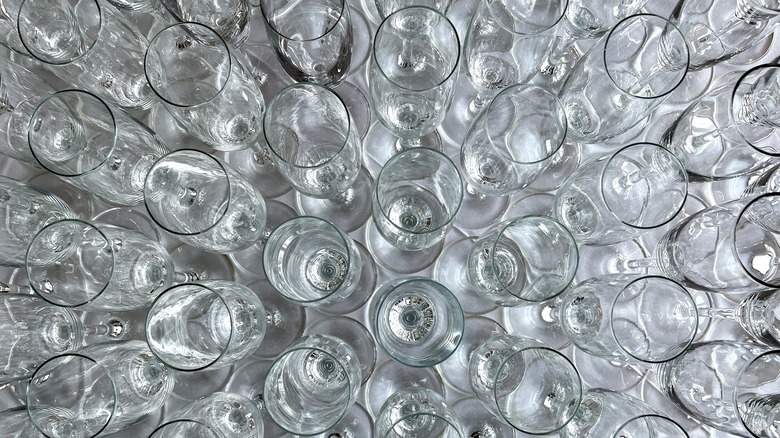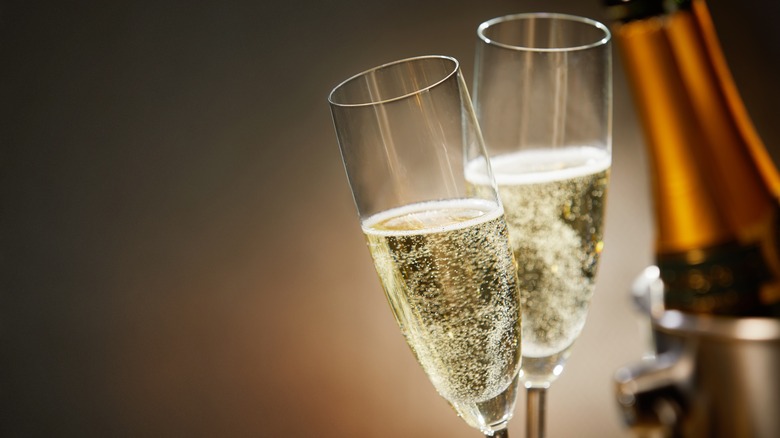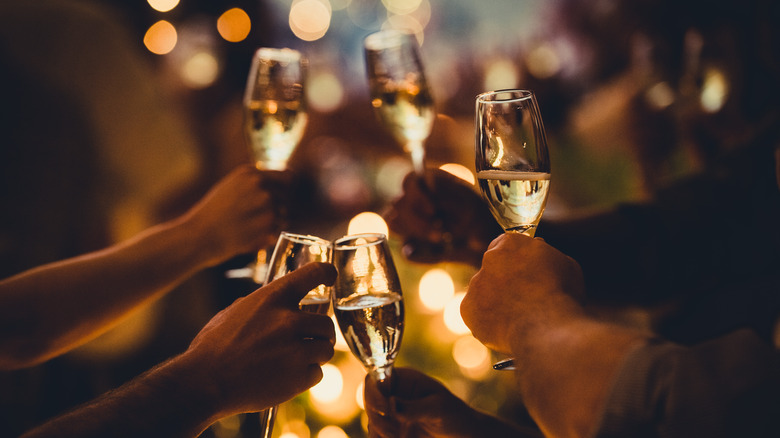Why It's Considered A Faux Pas To Wash Dusty Champagne Glasses
Champagne is practically synonymous with special occasions, but by definition, those don't happen every day. This means that for much of every year, Champagne-specific glassware, like flutes or coupes, is just collecting dust in your cabinets. What's the proper etiquette for cleaning them when another Champagne-worthy occasion arises? Many would-be revelers' first impulse is likely to re-wash the glasses, but that would be wrong — at least according to some experts in the bubbly beverage.
The reason is scientific. Yes, there's a science to Champagne, notably in the way the sparkling wine's trademark bubbles form. "Strictly speaking, there aren't actually bubbles in the wine until you open it, reducing the pressure and allowing the gas molecules to come together suddenly out of solution," notes Gerard Liger-Belair, a physicist from France's Champagne region, in BBC Future. "More bubbles form as the Champagne makes contact with imperfections and speckles of dust on the interior of a Champagne glass."
Yes, you heard that right. The presence of dust contributes to the effervescence of Champagne's iconic bubble. Does this mean, then, that you want dust in your Champagne glasses? Not necessarily — but it is a faux pas to wash them again.
Is dust good for Champagne?
Liger-Belair and a team of researchers at the University of Reims, located in the Champagne region, linked the degree of effervescence in the drink to the presence of dust and fibers in the glass. Their 2014 study, published in The Journal of Physical Chemistry, formulated a method for determining the actual number of bubbles in a glass of Champagne (about 1 million, on average). It also established that the intensity of effervescence makes a positive difference in flavor and aroma. So, according to these findings, dust should absolutely be left in glasses before pouring.
Other experts, however, including some manufacturers of high-quality Champagne stemware, beg to differ. According to their more traditional viewpoint, bubbles should exclusively form on the very bottom of the glass. That's why, in many cases, this part of Champagne glasses receives special treatment through etching. This promotes the proper dispersal of bubbles and leads to Champagne's characteristic "fountain" effect (via The Guardian). The bubbles, which fizz straight up, increase in speed as they do so, popping as they reach the top of the glass and dramatically impacting the wine's aroma. If bubbles form on the sides of glasses where lint or dust has accumulated, it's a sign that you haven't polished your glasses properly, according to this alternate theory.
How to properly clean Champagne glasses
For those who aren't Champagne experts, the real question is whether or not to clean dusty Champagne glasses before using them. Dust may indeed improve effervescence, but many will recoil from the idea of voluntarily consuming dust or lint.
If your Champagne glasses have been used, they should be washed, and hot-water washing is considered the only proper method. Purists eschew liquid soaps or detergents, as these may leave a residue that impacts the taste. Afterward, a lint-free cloth can be used to dry the glasses. If the glasses are on the shelves long enough to acquire dust before the next usage, dust can similarly be removed with this type of lint-free cloth. You can, of course, also leave the dust and enjoy the intensified bubbles.
Dust will likely always be an issue with Champagne flutes, not only because of spotty usage but because these are one of the few glass types that are appropriately stored upright rather than upside down, like cocktail glasses. This storage prescription is due to the delicacy of the flutes and rims, which are the most at-risk areas. This isn't an issue, however, if you embrace the dust.



